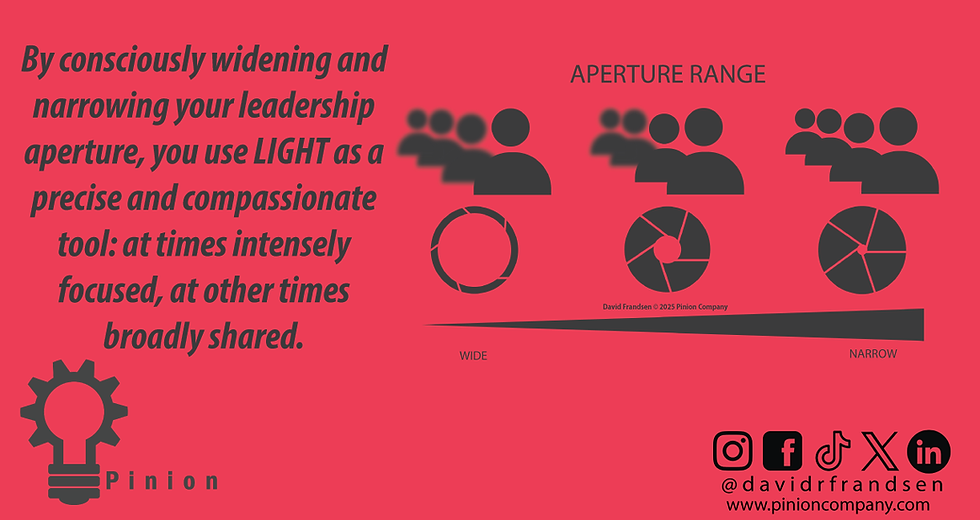Leadership Through the Planetary Gear System: Culture as a Verb
- David Frandsen
- May 19
- 3 min read
While working on my master’s degree in public administration, I decided to focus my studies on organizational culture in government. It did not take long to realize just how much culture matters-not just for building positive workplace relationships, but for shaping the very outcomes and successes of an organization. When culture is neglected, trust and motivation quietly erode, collaboration breaks down, and performance suffers. In government, where our work directly impacts the public, the stakes are even higher.
The deeper I got into the subject, the more I saw that culture isn’t just a trendy buzzword or a vague HR concept. It is a living, breathing force that shapes how people interact, make decisions, and show up to work every day. Culture influences everything-from employee happiness and engagement to innovation and resilience when challenges inevitably arise. And here’s the key: culture does not just “happen.” It takes real, intentional effort to create an environment where people feel valued, connected, and motivated to contribute their best.
Investing in culture means deliberately creating shared values, rituals, and norms that align with your organization’s purpose and goals. The more energy you give to nurturing culture, the stronger and more self-sustaining it becomes. This realization has shaped my entire approach to leadership and organizational development, and it is why I see culture as one of the four essential gears in my planetary model of leadership.
Culture as a Living Concept
Culture is not static; it’s a verb-something we do, not just something we have. Too often, people mistake culture for surface-level perks like ping pong tables or Christmas parties. But real culture is about creating an environment where people feel safe to grow, challenge themselves, and use their voices. Sometimes, the best culture is a little uncomfortable-because those moments of discomfort, honest feedback, and tough conversations are where the most meaningful growth happens.
A healthy culture is always evolving. It’s about connecting individual purpose with organizational purpose, prioritizing human connections, creating environments that are both safe and challenging, and allowing for continuous growth and adaptation.
Connecting Individual and Organizational Purpose
At the heart of strong culture is a clear, meaningful purpose. Generic mission statements do not inspire anyone. For our Public Works team, we settled on a simple, powerful purpose: “Make our city a better place to work and live.” When individual and organizational purposes align, extraordinary things can happen. It’s about creating a connection that goes beyond job descriptions and taps into what really motivates people.
The Social Dimension of Culture
Relationships are the foundation of any great workplace. As psychologist George Vaillant and business thinkers like Jim Collins have pointed out, people love what they do because they love who they do it with. That’s why we have made social connection a priority in our organization, here are a couple of quick examples.
The Daily Morning Meeting
We start each day with a morning meeting that brings everyone together-different departments, different roles. We share information, celebrate wins, and hold each other accountable. These meetings have become a simple yet powerful way to build team cohesion and develop leadership skills.
Ongoing Team Games
To break down silos and encourage real connections, I launched a year-long series of team games and events. These activities don’t take much time or money, but they have transformed how people interact, revealing hidden talents and new leaders. Most importantly, they’ve created genuine social moments that make people want to come to work.
Safe but Challenging Environments
The real magic happens when you create a workplace that’s both safe and challenging. People need to feel comfortable taking risks and sharing ideas, but they also need to be pushed to grow and reach their potential. When you strike that balance, you get the best out of your team-people step up, try new things, and support each other through both successes and failures. That is where true innovation and strong relationships take root.
Continuous Growth and Adaptation
A great culture is never static-it’s always growing and adapting. When people feel safe to share ideas, take risks, and learn from mistakes, the organization becomes more agile and resilient. Culture sets the tone for how we respond to change and solve problems together. The more we invest in building a culture that values learning and flexibility, the better equipped we are to thrive no matter what comes our way.
Conclusion
Culture is not something you can mandate or manufacture overnight. It emerges from intentional, consistent actions that prioritize people and meaningful connections. It’s about making space for laughter, honest conversations, and shared purpose. When you treat culture as a verb-something you actively do every day-it becomes the engine that drives happiness, growth, and real success. That’s the kind of culture I strive to build, and it is why I believe it deserves a central place in any model of effective leadership.





Comments